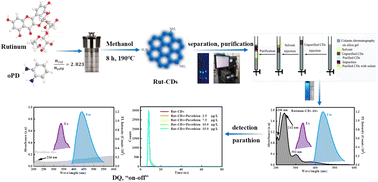Facile hydrothermal synthesis of N-doped fluorescent carbon dots for selective detection of insecticide parathion†
Abstract
Pesticides are enormously important to industry requirements and in agriculture for improving yields. Parathion is widely used to control pests in vegetables, fruits, and flowers. However, excessive use of parathion poses a threat to food safety, the environment, and human health. Due to low cost, ease to use, and high selectivity and sensitivity, a fluorescent nanoprobe is a candidate for parathion detection. Blue fluorescent carbon dots were prepared by a hydrothermal method with rutinum and o-phenylenediamine as precursors. The Rut-CDs were purified by using dialysis, thin layer chromatography, and a chromatographic column. Excellent linear ranges of 0–7.5 μg L−1 and 12.5–62.5 μg L−1 parathion were obtained with a low detection limit of 0.11 ng mL−1. In addition, the quenching mechanism of parathion to the fluorescence of Rut-CDs was illuminated. Furthermore, the nanoprobe was efficiently applied to determine the parathion content in Chinese cabbage, cantaloupe, and cowpea samples. It shows great potential to detect parathion.



 Please wait while we load your content...
Please wait while we load your content...